Note. The nut needs to be replaced "Nylstop" on the nut "Enko" (installed without the use of tack compound). If the car is already equipped with a type nut "Enko", there is no need to replace it - it can be used four times. On manual transmission models, new roll pins will be required during installation to secure the drive shaft to the differential.
Note. The grooves of the outer CV joint are covered with a tack compound. Therefore, a puller will be required to remove the hub assembly from the end of the drive shaft.
Removing
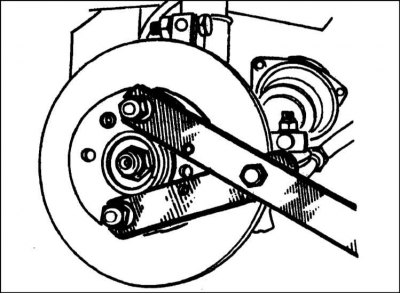
1. Remove wheel cap/hub cap (where available), then loosen the driveshaft nut as well as the wheel bolts.
2. Block the rear wheels, engage the handbrake, then jack up the front of the vehicle and place it on axle stands. Remove the front wheel.
3. On models equipped with ABS, remove the wheel speed sensor as described in Chapter Brake system.
4. Remove the drive shaft mounting nut. If the nut was not loosened before the car was jacked up (refer to paragraph 1), install the two wheel bolts into the hub and tighten them securely. Have an assistant firmly depress the brake pedal to lock the hub, then use the socket and extension rod to loosen and remove the nut. Alternatively, make a forked tool out of two pieces of steel strip (one long, one short), by connecting them with a bolt and nut. Attach the tool to the hub using the two wheel bolts, and while holding it stationary, unscrew the drive shaft mounting nut.
5. Remove the two bolts securing the brake caliper assembly to the steering knuckle and remove the assembly from the disc. Use a piece of wire or twine to tie the caliper to the front suspension spring, being careful not to stretch the brake hose.
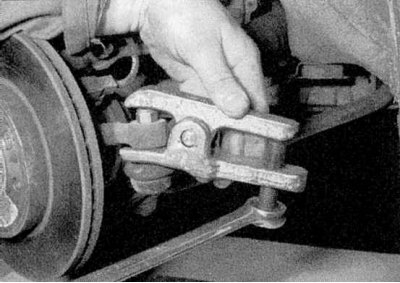
6. Loosen and remove the nut securing the tie rod end ball joint to the steering knuckle. Release the ball joint pin with a special puller (refer to accompanying illustration).
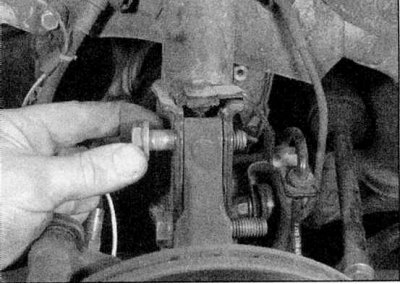
7. Loosen and remove the two nuts and their washers from the bolts securing the steering knuckle to the suspension strut. Please note that the nuts are located on the back of the rack. Remove the top bolt, the bottom bolt should remain in position at this point (refer to accompanying illustration).
Left Drive Shaft - Manual Transmission Models
1. Drain transmission oil as described in Chapter Maintenance.
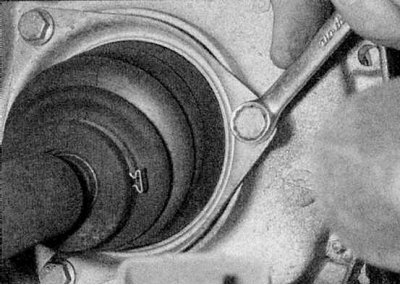
2. Loosen and remove the three bolts securing the protective boot plate to the transmission wall (refer to accompanying illustration).
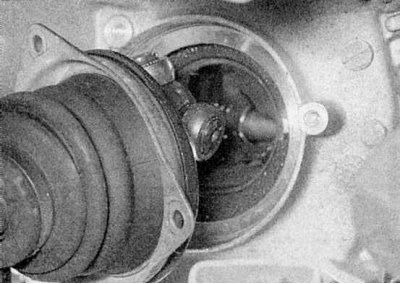
3. Pull the upper part of the steering knuckle out so that the SHRUS tripod comes out of its body (refer to accompanying illustration). Be prepared for oil to come out and make sure that the rollers do not fly off the tripod.
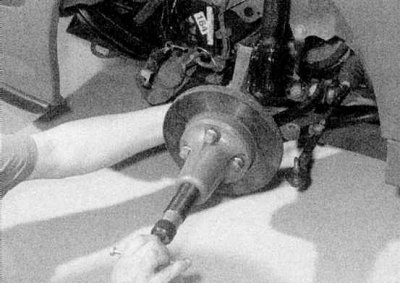
4. Remove the lower bolt securing the steering knuckle to the suspension strut. Separate the outer CV joint from the hub and remove the drive shaft using a hammer and a soft metal drift. Ask an assistant to hold the hub while doing this and try not to damage the protective covers. If this method doesn't work, use a puller (refer to accompanying illustration). Lock the hub assembly by inserting bolts into the strut base.
Right Drive Shaft - Manual Transmission Models
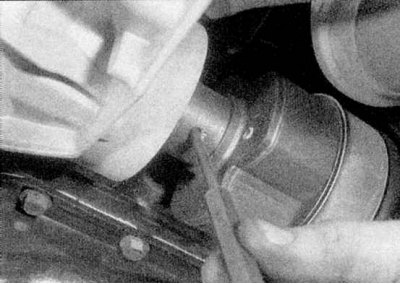
1. Rotate the drive shaft until the roll pins securing the inner CV joint to the differential side gear shaft are visible. Using a hammer and a 5 mm punch, drive out the roll pins (refer to accompanying illustration). New pins must be used during installation.
2. Pull the top of the steering knuckle out to separate the inner CV joint from the differential side gear shaft. Remove the O-ring from the gear shaft (where available).
3. Remove the drive shaft as described above.
4. Pull the top of the steering knuckle out and separate the inner CV joint from the drive flange.
5. Remove the drive shaft as described above.
Installation
1. Genuine Renault drive shafts are shipped in cardboard or plastic packaging to prevent damage to the protective covers. Even a slight blow to the case can cause it to puncture. If the removed drive shaft cannot be replaced, it is recommended to place it in a similar package made of cardboard.
Left Drive Shaft - Manual Transmission Models
1. Wipe the walls of the transmission housing and the grooves of the outer CV joint.
2. Insert the CV joint tripod into its body, keeping the drive shaft in a horizontal position. Align the holes in the protective boot mounting plate with the holes in the differential case. Establish fastening bolts and tighten them the effort resulted in Specifications. Make sure the protective cover is not twisted.
3. Clean and dry the grooves of the hub and the outer CV joint and apply a tack compound to the grooves of the drive shaft (Renault recommends Lostite Scelbloc).
4. Move the upper part of the steering knuckle inward, guiding the drive shaft into the hub.
5. Push the drive shaft all the way into the hub, then insert the two suspension strut mounting bolts (from the front of the car). Install washers and nuts on the bolts and tighten them to the Specifications the effort of the Head Suspension and steering).
6. Clean the threads of the caliper bracket mounting bolts and coat with tack compound (Renault recommends Lostite Frenbloc). Establish a support in working position and tighten bolts of an arm of a support given in Specifications by effort of the Head Brake system.
7. Block the hub and tighten the drive shaft mounting nut to the specified torque. Alternatively, tighten the nut only lightly for now, postponing final tightening until the vehicle is lowered onto its wheels.
8. Make sure that the hub rotates freely, then carefully remove the protective packaging from the CV joints.
9. Install the wheel. Lower the car on the earth and tighten bolts of a wheel the effort resulted in Specifications. If not already done, also tighten the drive shaft mounting nut.
10. Fill the transmission with the type and amount of oil specified in the Specifications and check its level (contact the head Maintenance).
Right Drive Shaft - Manual Transmission Models
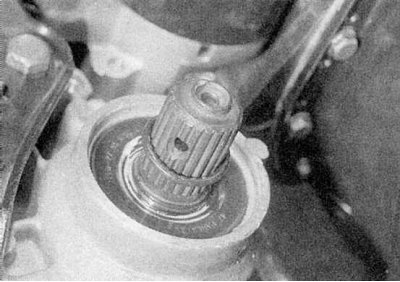
1. Clean and dry the grooves of the inner CV joint and differential side gear shaft. Apply a small amount of molybdenum grease to them (Renault recommends Molykote BR2). Where necessary, install a new O-ring on the end of the pinion shaft and slide it along the shaft against the transmission oil seal (refer to accompanying illustration).
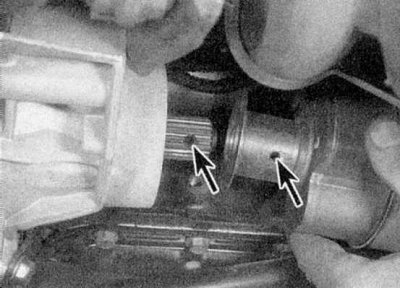
2. Push the drive shaft onto the grooves of the side gear shaft, aligning their holes for the cylindrical pins (refer to accompanying illustration).
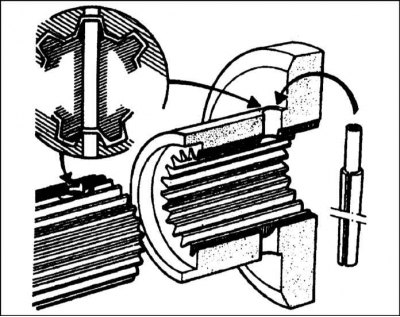
3a. The location of the cylindrical pin of the inner CV joint of the right drive shaft.
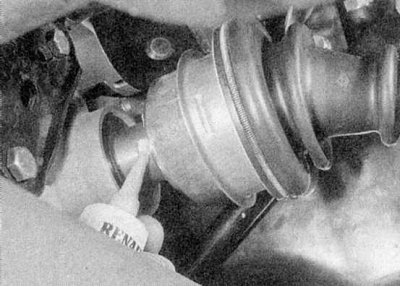
3b. Install new roll pins so their grooves are 180°apart, then apply sealant to the ends of the pins (Renault recommends CAF 4/60 THIXO or Rhodoseal 5661) (refer to illustrations).
4. Follow the steps for the LEFT DRIVE SHAFT - MANUAL TRANSMISSION MODELS.
Both drive shafts - AD4 automatic transmission models
1. Clean and dry the grooves of the inner CV joint and differential side gear shaft. Apply a small amount of molybdenum grease to them (Renault recommends Molykote BR2).
2. Push the inner CV joint into the grooves of the side gear shaft.
3. Follow the steps for the LEFT DRIVE SHAFT - MANUAL TRANSMISSION MODELS.
